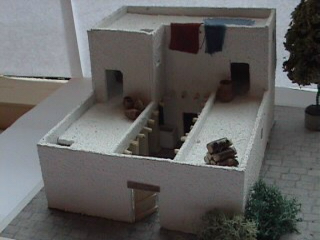
Tel Abel Beth Maacah is a large archaeological tell with a small upper northern section and a large lower southern one, connected by a saddle. It is located on the northern border of present-day Israel, about 2 km south of the town of Metulla and about 6.5 km west of Tel Dan.

Philistia, also known as the Philistine Pentapolis, was a confederation of cities in the Southwest Levant, which included the cities of Ashdod, Ashkelon, Ekron, Gath, Gaza, and for a time, Jaffa. It was populated by the Peleset, or Philistines, who are believed to have been an Indo-European people who settled in Canaan around the year 1200 BC; they had particular resemblances to the Mycenaean civilization. At its maximum territorial expansion, its territory may have stretched along the Canaanite coast from Arish in the Sinai to the Yarkon River, and as far inland as Ekron and Gath. Nebuchadnezzar II invaded Philistia in 604 BC, burned Ashkelon, and incorporated the territory in the Neo-Babylonian Empire; Philistia and its native population the Philistines disappear from the historic record after that year.
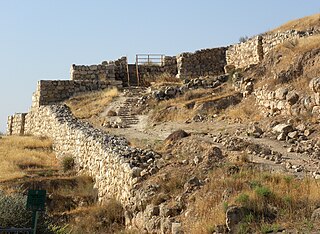
Lachish was an ancient Canaanite and Israelite city in the Shephelah region of Israel, mentioned several times in the Hebrew Bible. The current tell (ruin) by that name, known as Tel Lachish or Tell ed-Duweir ,, has been identified with the biblical Lachish. Today, it is an Israeli national park operated and maintained by the Israel Nature and Parks Authority. It lies near the present-day moshav of Lakhish.

The city of Ekron, in the Hellenistic period known as Accaron was a Philistine city, one of the five cities of the Philistine Pentapolis, located in present-day Israel.
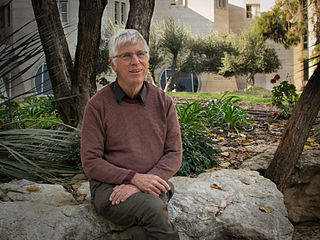
Amihai "Ami" Mazar is an Israeli archaeologist. Born in Haifa, Israel, he has been since 1994 a professor at the Institute of Archaeology of the Hebrew University of Jerusalem, holding the Eleazer Sukenik Chair in the Archaeology of Israel.

Tell Qasile is an archaeological site in Tel Aviv, Israel. Over 3,000 years old, the site contains the remains of a port city founded by the Philistines in the 12th century BC. It is located near the Yarkon River, on the grounds of the Eretz Israel Museum.
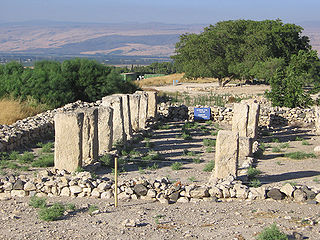
Tel Hazor, also Chatsôr, translated in LXX as Hasōr, identified at Tell Waqqas / Tell Qedah el-Gul, is an archaeological tell at the site of ancient Hazor, located in Israel, Upper Galilee, north of the Sea of Galilee, in the northern Korazim Plateau. In the Middle Bronze Age and the Israelite period, Hazor was the largest fortified city in the country and one of the most important in the Fertile Crescent. It maintained commercial ties with Babylon and Syria, and imported large quantities of tin for the bronze industry. In the Book of Joshua, Hazor is described as “the head of all those kingdoms”.

The ruins of Gedi are a historical and archaeological site near the Indian Ocean coast of eastern Kenya. The site is adjacent to the town of Gedi in the Kilifi District and within the Arabuko-Sokoke Forest.

The megaron, plural megara, was the great hall in very early Mycenean and ancient Greek palace complexes. Architecturally, it was a rectangular hall that was surrounded by four columns, fronted by an open, two-columned portico, and had a central, open hearth that vented though an oculus in the roof.
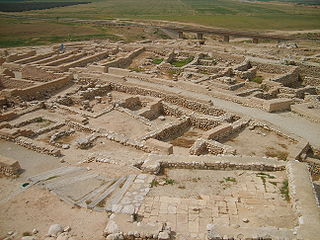
Tel Sheva or Tel Be'er Sheva, also known as Tell es-Seba, is an archaeological site in the Southern District of Israel, believed to be the site of the ancient biblical town of Beer-sheba. The site lies east of modern Beersheba and west of the Bedouin town of Tel Sheva. Tel Sheva has been preserved and made accessible to visitors in the Tel Be'er Sheva National Park.

The Tall Zira'a is an archaeological tell in Jordan. Surveys and geophysical investigations showed the site's great potential for excavations.
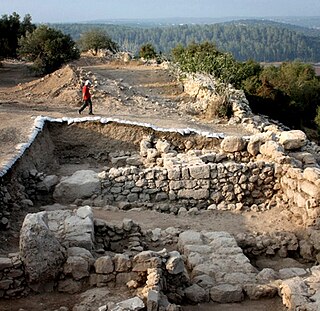
Khirbet Qeiyafa, also known as Elah Fortress and in Hebrew as Horbat Qayafa, is the site of an ancient fortress city overlooking the Elah Valley and dated to the first half of the 10th century BCE. The ruins of the fortress were uncovered in 2007, near the Israeli city of Beit Shemesh, 30 km (20 mi) from Jerusalem. It covers nearly 2.5 ha and is encircled by a 700-meter-long (2,300 ft) city wall constructed of stones weighing up to eight tons each. Excavations at site continued in subsequent years. A number of archaeologists, mainly the two excavators, Yosef Garfinkel and Saar Ganor, have claimed that it might be one of two biblical cities, either Sha'arayim, whose name they interpret as "Two Gates", because of the two gates discovered on the site, or Neta'im; and that the large structure at the center is an administrative building dating to the reign of King David, where he might have lodged at some point. This is based on their conclusions that the site dates to the early Iron IIA, ca. 1025–975 BCE, a range which includes the biblical date for the biblical Kingdom of David. Others suggest it might represent either a North Israelite, Philistine, or Canaanite fortress, a claim rejected by the archaeological team that excavated the site. The team's conclusion that Khirbet Qeiyafa was a fortress of King David has been criticised by some scholars, but has been validated by the Israel Antiquities Authority (IAA).
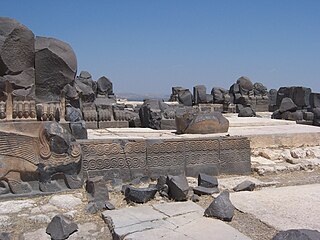
The Ain Dara temple is an Iron Age Syro-Hittite temple noted for its similarities to Solomon's Temple, also known as the First Temple, as described in the Hebrew Bible. It is located near the village of Ain Dara, in Afrin, Syria. According to the excavator Ali Abu Assaf, it existed from 1300 BC until 740 BC and remained almost unchanged during the construction of Solomon's Temple as it had been before, so that it predates the Temple. The temples of Emar, Mumbaqa, and Ebla are also comparable, as is the nearby 8th-century Tell Tayinat temple. The surviving sculptures depict lions and sphinxes.
Giloh was a city in Judah. The biblical town has been identified with Beit Jala.
Kuntillet Ajrud is a late 9th/early 8th centuries BCE site in the northeast part of the Sinai Peninsula. It is frequently described as a shrine, though this is not certain.
Tell Abu al-Kharaz is an archeological tell in the Irbid Governorate of modern-day Jordan. Tell Abu al-Kharaz was the site of a fortified town during the Bronze and Iron Ages; it is located in the Jordan Valley, 4 kilometers east of the Jordan River.
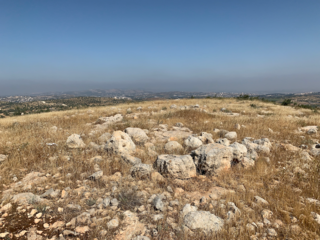
The so-called Bull Site at Dhahrat et-Tawileh, also spelled Daharat et-Tawileh, in the West Bank is an open air ancient cult installation from 12th-century BCE Canaan, where the bronze statuette of a bull was found.

Tel Qiri is a tel and an ancient village site located inside the modern kibbutz of HaZore'a in northern Israel. It lies on the eastern slopes of the Menashe Heights and the western edge of the Jezreel Valley. As of the beginning of the excavations in 1975, almost half of the site was still visible, but today the entire site is covered by the houses of HaZore'a. The site spans an area of one hectare and is believed to have been a dependency of the nearby Tel Yokneam. The site hosted some human activity during the Neolithic and Chalcolithic periods, as well as parts of the Bronze Age. An uninterrupted sequence of settlement lasted from the Iron Age to the Roman-Byzantine period. Unlike all urban centers in northern Israel, the village in Tel Qiri, which flourished during the Iron Age, escaped all military events and no traces of destruction can be found there. This minor, damaged and seemingly insignificant site yielded an amazingly rich and diverse quantity of remains of different periods.

Tell Qudadi, also known as Tell esh-Shuna is an ancient site located near the mouth of the Yarkon River and the Reading Power Station in the city of Tel Aviv, Israel. It was discovered in 1934 by Jacob Ory and was excavated first by P. L. O. Guy in 1937 and then by Eleazar Sukenik, Shmuel Yeivin and Nahman Avigad in 1937-1938. They discovered a fortress dated to the Iron Age and believed that it was an Israelite fortress built in the 10th or 9th centuries BCE and destroyed by the Neo-Assyrian Empire in the 8th century BCE.

Temple in antis is an architectural design that became popular in Syria and other parts of the Levant starting in the Early Bronze Age and persisting until the Iron Age. Arriving from Northern Syria whether from Assyrian or Amorite diffusion, the temples share similar characteristics with some home designs from Anatolia in modern Turkey. Most of the Temples follow similar design plans making it easy to track their spread across the Levant. These temples give a glimpse into the religious practices and urbanization that took place in the Levant during the Bronze and Iron Age.
